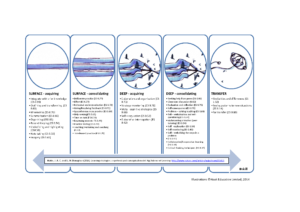Just as there are “different horses for different courses” so there are different learning strategies for different stages of the learning process
A recent article by John Hattie and Gregory Donoghue (2016) uses meta-analyses, effect sizes and a more nuanced model of surface and deep understanding to look at learning strategies in ways that will help us create versatile thinkers.
In an elegant new model of learning they differentiate surface, deep and transfer in the learning process and #SKILL #WILL and #THRILL as inputs and outputs. They use this model to investigate the effects derived from meta-analyses of research that related learning strategy to achievement.
It is an important article – one that will spark fabulous and ongoing professional discussion in schools. It is research that matters in that it promotes and enables versatile thinking in students.
I have tried to capture the Hattie Donoghue #SKILL process steps in the table below. The addition of the meta-analysis will markedly improve teacher and student versatility when thinking about the best learning learner strategies for any given moment in learning. Check out the effect size and positioning of collaboration as a strategy.

Reference: Hattie, J. A. C.and Donoghue, G. M. (2016). Learning strategies: a synthesis and conceptual model. Review Article Number 16013. npj Nature Partner Journals Science of Learning.
Why do I post this?
If you read our curriculum documents – there are claims that we should focus on creating young people who are critical and creative thinkers. It is a pedagogical challenge that I have spent much of my professional life examining. I spent time designing and implementing a thinking curriculum – describing what it would look like and determining the effective pedagogies for sharing this with students -explicit/infused etc. and then implementing this across schools. However, my recent work with SOLO Taxonomy has changed my perspective. When I look at some of the critical and creative thinking materials and suggested approaches – I wonder if we have been distracted and asking the wrong question all along.
Working with SOLO as a model changed my thinking not because it makes surface and deep outcomes visible, but rather because SOLO is a nuanced way to show learning process – from surface to deep to conceptual. In doing this SOLO enables us to categorise learning strategies in ways that help students choose when best to use them. In this way SOLO helped develop student “versatility in thinking”. I have come to believe that versatility is closer to what matters for students than simplistic exhortations to become creative or critical thinkers.
There are many thinking skills and strategies and e-learning apps that purport to help students learn. In the classroom based use of SOLO I encourage teachers and students to categorise these learning strategies by SOLO level of the task. In doing this they create their own SOLO based Learning Strategy Toolboxes. The decision making around when to use a strategy helps develop “versatile thinking”.
You can see some of my early thinking about this below. The addition of the new thinking around “acquiring” and “consolidating” surface and deep learning and the results from the meta-analyses makes this so much better.




